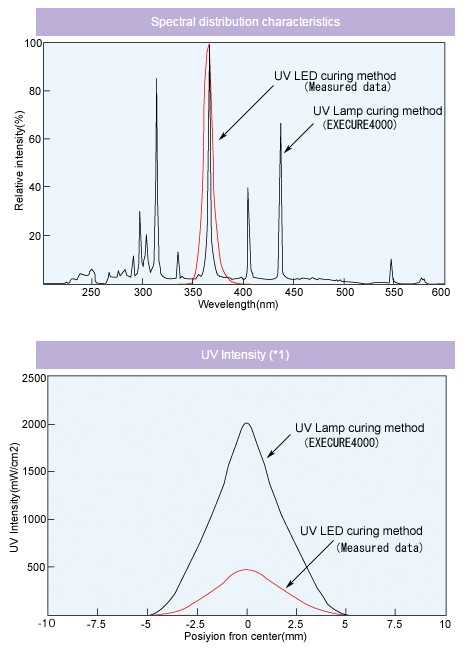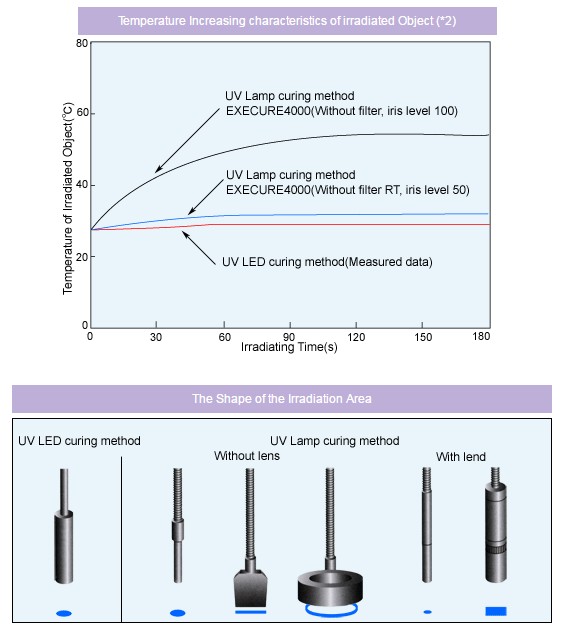HOYA UV-LED Curing System
UV Curling Systems
What is UV curing?
Curing is converting photo resist from a liquid into a solid utilizing light energy.
UV curing is a light curing process that utilizes the energy of ultraviolet (UV) radiation invisible to the human eye.
UV curing has several superior characteristics. The main characteristics are as follows.
1.Rapid curing speed
The adhesive can be cured from a few seconds to a few tens of seconds, depending on the irradiation conditions of the UV light and the characteristics of the adhesive.
2.Heat application unnecessary
As the process utilizes UV light energy, application of heat is unnecessary.
This is suited for adhesive applications that are sensitive to heat.
3.Minimal emission of hazardous substances
As the amount of hazardous substance emitted during curing is minimal, this process is considered environment friendly.
4.Easy positioning
As the adhesive does not cure until the UV light is irradiated, this is suited for precise adhesive applications where positioning is necessary after application of the adhesive.
How Is It Different from UV LED Curing Method?
UV curing has two types: UV Lamp curing method and UV LED curing method. Here is a look at the item-by-item comparison.
1.Cost
Compared with UV Lamp curing method, UV LED curing method has an advantage in power consumption, but its device (controller) and consumable parts (LED heads) are both expensive.
Especially for the recent curing process that needs to cure plural points at the same time in order to reduce the tact time, UV Lamp curing method can be relatively inexpensive by using poly-branch light guide, whereas the UV LED curing method requires an expensive LED head for each irradiation point, resulting in a large difference in the cost.
2.Compatibility with Adhesives
It is widely known that not only the action of 365 nm, but also the auxiliary actions of other wavelengths are important in UV curing.
UV Lamp curing method can irradiate UV light with a wide range of wavelengths centering at 365 nm.
In addition, it is also easy to control the wavelength range of light, using a filter depending on the characteristics of adhesives.
UV LED curing method uses a single wavelength light based on 365 nm, and it is not suited for a wide variety of adhesives.
3.UV Intensity
The intensity of UV LED curing method is generally lower than that of UV Lamp curing method, which results in different tact times.
4.Heat Damage to Irradiated Objects
UV LED curing method gives the impression that it does less heat damage to irradiated objects than UV Lamp curing method does. Is this true?
Compared to UV LED curing method, UV Lamp curing method uses a higher-power light of wider wavelength range, therefore, a direct comparison of these methods yields no accurate data.
Our comparative examination under the same condition has yielded the result that the temperature rise characteristics of irradiated objects are approximately equivalent.
5.The Shape of the Irradiation Area
UV LED curing method is combined with front lens, and the irradiation area generally becomes circular. In UV Lamp curing method, on the other hand, combination with various light guides and lenses enables applications corresponding to the actual irradiation areas.


(*1)Comparison data with an irradiation distaqnce of 25mm.
The data of UV Lamp curing method shows its standard characteristics of the combination of EXECURE 4000, custom-designed U4B7F100-1570, and HLL-L2.
(*2)Data from temperature rise characteristics of a 10.0 x t 0.8 aluminum plate.
For UV Lamp curing method, FG3B5F1000UVR-HT4 was used with EXECURE 4000, and the data, indicated side-by-sude, were obtained under two conditions: one with the iris level at 100 without filter, and another with Filter RT and the mechanical iris setting adjusted to create approximately equivalent wavelength and intensity of the UV LED light.

